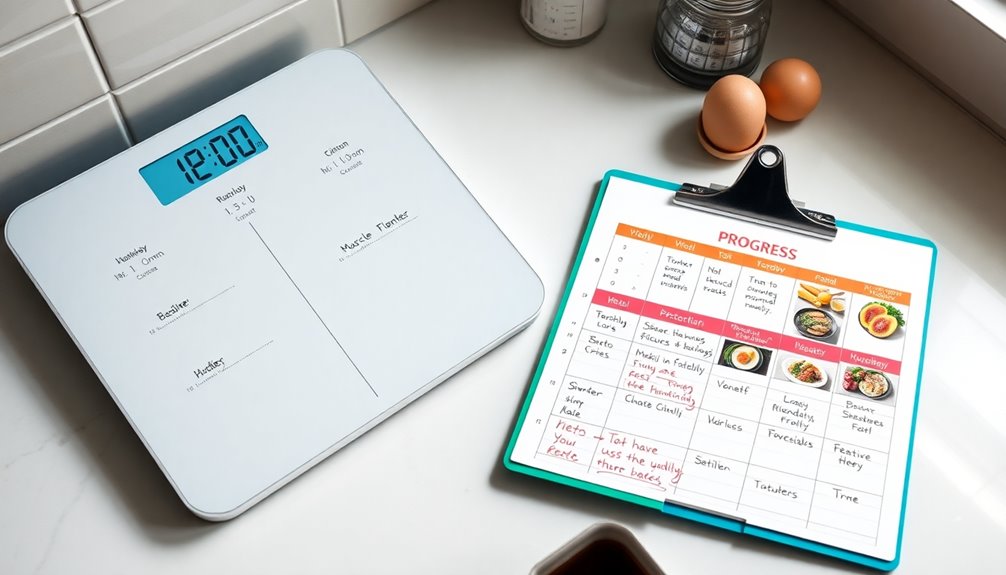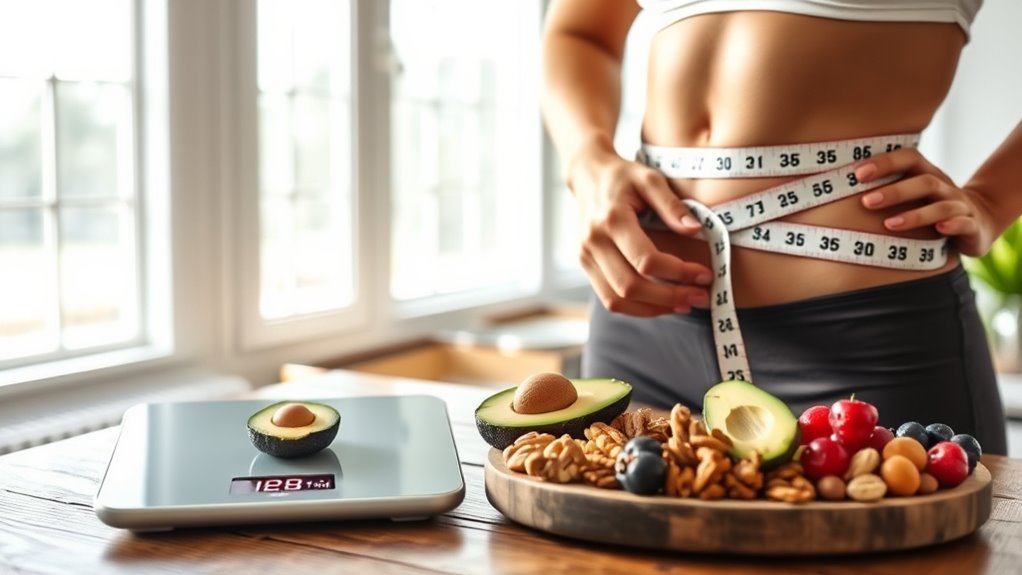To track progress on keto beyond the scale, focus on body measurements, progress photos, and how you feel. Your body might lose fat and gain muscle, which can keep your weight steady but still show improvements. Also, monitor how your energy, mental clarity, and sleep quality change over time. Paying attention to these indicators gives a clearer picture of your success, and you’ll discover more effective ways to stay on track as you explore further.
Key Takeaways
- Use body measurements like waist, hips, and limbs to detect changes not visible on the scale.
- Take regular progress photos to visually track body transformations over time.
- Monitor personal signs such as energy levels, mental clarity, and hunger to gauge diet effectiveness.
- Track macronutrient ratios and fasting patterns to maintain ketosis and optimize fat loss.
- Assess overall health markers like sleep quality and hydration to support sustainable keto progress.

Have you ever wondered how to effectively track your progress on a keto diet? Relying solely on the scale can be misleading, especially when your body undergoes changes like muscle gain and fat loss simultaneously. Instead, consider focusing on other indicators that reflect your progress more accurately. One key aspect is paying attention to your macronutrient ratios. On keto, maintaining the right balance—typically about 70-75% fats, 20-25% protein, and only 5-10% carbs—is essential. Tracking these ratios helps you stay in ketosis and ensures your body is burning fat for fuel rather than carbohydrates. Use a food diary or app to log your daily intake, so you can see if you’re meeting your targets consistently. This not only keeps you accountable but also helps identify any patterns or deviations that might stall your progress.
Track macronutrient ratios to stay in ketosis and monitor fat burning effectively.
Meal timing plays a significant role as well. While keto doesn’t require strict intermittent fasting, some people find that adjusting meal timing can enhance fat burning and improve mental clarity. For example, having longer fasting periods overnight or spacing meals to extend the time between eating can help your body become more efficient at burning stored fat. Pay attention to how your body responds to different meal schedules—notice whether you feel more energized, less hungry, or clearer-minded. These subtle signs are valuable indicators of progress that the scale won’t show. Additionally, incorporating natural materials like linen or wood in your kitchen setup can support a more mindful and health-conscious lifestyle, aligning with your dietary goals. Furthermore, understanding and monitoring your metabolic health can provide deeper insights into your body’s response to the keto diet. Regularly reviewing these markers can help you fine-tune your approach for better results.
Tracking body measurements such as waist, hips, arms, and thighs can reveal changes that aren’t reflected on the scale, offering a more comprehensive view of your progress. Including sleep quality as a metric can also be a useful indicator of overall health improvements during your keto journey. Beyond macronutrient ratios and meal timing, consider tracking other physical and mental markers. Take regular progress photos to visualize body changes over time—sometimes, your clothes fit better even if the scale hasn’t moved much. Measure your waist, hips, arms, and thighs periodically to see where fat loss is occurring. Keep track of your energy levels and mental clarity; many people experience increased focus and reduced brain fog on keto, which signals positive adaptation. Hydration and electrolyte balance are also critical; paying attention to these can prevent common issues like fatigue or muscle cramps, helping you stay consistent.
Ultimately, successful keto tracking involves a holistic approach. Use multiple tools—macronutrient logs, meal timing adjustments, body measurements, and personal observations—to get a thorough picture of your progress. This way, you’ll stay motivated and make informed tweaks, rather than fixating on a number that doesn’t tell the full story. Remember, keto success isn’t just about weight loss; it’s about how you feel, how your body responds, and how sustainable your habits become over time. Incorporating data privacy awareness can also help you choose reliable apps and tools that protect your personal health information.
Frequently Asked Questions
How Long Does It Typically Take to See Non-Scale Keto Progress?
You might notice non-scale keto progress within a few weeks, but it varies. As you go through the fat adaptation timeline, you could experience fewer keto flu symptoms and increased energy. Typically, visible changes like better mental clarity or improved endurance appear around the 3-4 week mark. Remember, everyone’s different—focus on how you feel and your body’s signals rather than just the scale for true progress.
What Are Some Signs of Keto Adaptation Beyond Weight Loss?
Did you know that within a few weeks of starting keto, many people notice increased energy levels and mental clarity? Signs of keto adaptation include stable blood ketone levels, which indicate your body’s switch to burning fat efficiently. You might also experience reduced hunger, improved focus, and better sleep. These changes show your body is adapting beyond just losing weight, making keto a sustainable and effective lifestyle.
Can Mood Swings Indicate Progress or Setbacks on Keto?
Mood swings can sometimes indicate emotional fluctuations as your body adapts to keto. You might experience setbacks if these swings feel intense or persistent, signaling your system is adjusting. Conversely, if you notice improved diet satisfaction and more stable emotions over time, it suggests progress. Paying attention to your emotional response helps you gauge your keto journey beyond just physical changes, ensuring you’re staying balanced and motivated.
How Do Muscle Gains Relate to Keto Diet Monitoring?
Muscle gains, body composition, and progress all intertwine on your keto journey. When you focus on muscle growth, you see changes in your body composition—more muscle, less fat—that aren’t always reflected on the scale. Tracking these aspects helps you understand your progress better. You notice increased strength, improved posture, and a toned physique, which all signal positive shifts beyond just weight, keeping you motivated and aligned with your goals.
Are There Specific Biomarkers to Track Keto Success Beyond Scales?
You can track your keto success beyond the scale by monitoring blood ketone levels and insulin sensitivity. Blood ketone levels show how well your body is producing and using ketones for energy, indicating ketosis. Improved insulin sensitivity means your body responds better to insulin, reducing fat storage. These biomarkers give you a clearer picture of your progress, helping you stay motivated and fine-tune your diet for ideal results.
Conclusion
Remember, tracking your keto journey isn’t just about the scale. Did you know that some people experience a 5-10% reduction in body fat within just a few weeks? By paying attention to how your clothes fit, energy levels, and even sleep quality, you get a fuller picture of your progress. Keep celebrating small wins beyond the numbers, and stay motivated—your health transformation is about more than just weight loss!









